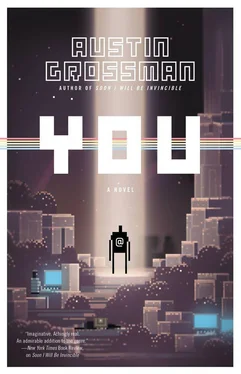Procyon holds a mystery, a stone temple in the equatorial jungle, built (your scientists tell you) approximately the year the Beatles recorded Revolver and made from stone native not to the planet itself but to the planet’s second moon. You find one like it on Epsilon Indi’s second planet, another on a planet orbiting L5 1668. They contain carvings that, when compared, yield a coded schematic for a machine that can pull on the space between stars and very slightly condense or wrinkle it. Your people call it a warp drive.
Crossing the centuries at one bound, you move to the next historical phase…
The Cosmopolitan Age
It is three centuries later, and your ships go faster. Humanity’s reach spans 250 light-years. There are fifteen hundred stars now, more than you can name personally. There are four warp-capable alien species whose volumes of influence interpenetrate with your own. You know of two dozen other sentient life-forms in industrial or preindustrial phases of civilization.
Outside, the leaves are starting to turn, and you’re a year older, and the incipient chill and the smells of rain and rotting leaves bring on an involuntary sense memory of the expectation of school and book bags and new teachers. Or is part of that memory buried in the code itself, in the mind that made it, in the cool fall air of the garage, the new possibilities that grew from the summer of 1983? You don’t know. But the second X means “expand.”
As Ley-R4, you continue to rule, empress, sage, and justice in perpetuity. The other three Heroes serve as your ministers, immortal figureheads of the fields of human endeavor they represent. Loraq is the philosophical and religious head of the empire. Pren-Dahr administers economics (well, exploitation) and diplomacy, and Brendan Blackstar, of course, handles the military.
Rogue colonies, border wars, and piracy trouble the empire’s peace. And stranger things happen—ships go missing or turn up empty or hull-breached. You find, once, a ship’s crew butchered as if by a preindustrial weapon. And from time to time a colony or a world goes dark and is found depopulated, whether by disease, environmental failure, an uprising of indigenous flora or fauna, or simply with no explanation at all. Even the occasional star explodes. You wonder if Mournblade’s reach is this far.
The galaxy is a large and strange place, and it’s only a matter of time before monsters come out of the darkness. That’s how the age ends, with the arrival of a vast and ancient fleet that swallows a quarter of the empire overnight. The Cosmopolitan Age is over, and the Spindrift War begins.
The Spindrift War
The view scale jumps again, and humanity’s existence is threatened, and it’s time to exploit, which is the third X . Asteroids are quarried into massive fleets equipped with the Improved Gravity Splice. Combat is now too fast to follow on a tactical level, so you learn to program artificial intelligence systems. The weapons are terrible: entire planets are shattered and stars implode on your orders. By the time the Terpsichore Myriad (for so they call themselves) is exterminated, the human dominion comprises six hundred million stars (out of the galaxy’s two hundred billion) and thirty thousand light-years, almost a third of the way across the galaxy, but still far short of your goal. The war has paved the way to a Golden Age.
The Golden Age
Now the galaxy blazes with life from its core to the outer reaches, incomparably great and ancient. The view scale pulls back to encompass sixty thousand light-years at its farthest zoom, and the galaxy’s large-scale forms finally come into view—the fuzzy logarithmic spiral, the globular clusters at the rim, the long bar, which passes through the central disk.
The breadth and variety is extraordinary and never-ending. The sensation is one of an inner fullness, limitless wealth, the barely remembered feeling of needing to hug yourself and jump up and down in the effort to contain sheer happiness. You start to see, as never before, the scope of Black Arts’ achievement. You can’t believe they’ve given you this gift. It’s a very, very, very nearly perfect game.
The game can end in many ways, but each character has its own special ending, which you may or may not be able to achieve.
Brendan Blackstar
If you’re Brendan, there is an extra subphase late in the Golden Age when a challenger emerges, a nemesis triggered by your own aggressive philosophies, a master politician and strategic genius. The military victory occurs only when you have driven your opponent’s forces back to their home planet and dueled him yourself on the marble steps of his palace. You fight as a white-haired general, vibro-sword to laser ax, and throw his severed head to the crowd.
Pren-Dahr
Pren-Dahr’s victory is more of a statistical threshold triggered by careful management of production and trade, which, as they reach a certain level of productivity, obviate the need for wealth itself. Our last view of Pren-Dahr shows him as an old man in retirement, gazing out over a golden city, one of a million cities in a galaxy that will know an eternity of plenty.
Loraq
Loraq attains victory as a galactic philosopher-king who, as head of the Galactic Council, is empowered to adjudicate border disputes, enact various galaxy-wide rulings—such as caps on weapons production or mining or expansion—and set the penalties for violating them. In time, it’s possible to play with the way various species-wide AIs react and realize a galaxy-wide peace. If it can be maintained for a full galactic rotation, the conditions are met and the result is an eternity of peace and wisdom as the formerly disgraced vizier is at last allowed to rule in his own right.
Ley-R4
If you’re Ley-R4, you may at long last decipher the Precursor technology. Then, if you have the requisite technologies, you can invest resources to create the reality engine, the hidden apex of the game’s broad and deep technology tree. When activated, it triggers the Science Victory, the creation of a new parallel universe to explore. The game ends, but you finish knowing that, for Ley-R4, the cycle of exploration need never end.
There are other moments that go unseen, fragments of the Heroes’ long, long lives that will never enter the histories. Eleven-year-old Loraq lying on his flowered coverlet looking up at the ceiling and listening to bootleg cassette tapes of The Hitchhiker’s Guide to the Galaxy . Pren-Dahr delivering the valedictory address at his college and finding, looking down at the familiar bored or smiling or nervous faces, that he feels nothing. Brendan Blackstar straying from the path on a summer-camp hike and finding himself alone for the first time in weeks.
The game doesn’t end. A millennium passes, and then another, with nothing but a long, extended moment of peace and vitality. All victory conditions have been met, but the game won’t end—the galaxy’s golden moment continues while outside days pass, a wet summer to a dry autumn.
You comb through the galaxy’s wonders for anything you’ve missed. Cities of white towers, jungle cities dripping long tangles of vegetation, undersea cities, cities in hollowed-out moons. You catalog all the Precursor temples—what was going on there? You think you’ve got all of them—you ended up glassing a few planets from orbit back in the Spindrift (a couple dozen, if we’re being honest with ourselves), and one of them might have been important, but you make do with what you have.
The temple complexes are all unique and beautifully modeled. Each one has its own style and carvings, and each one has been artfully smashed to pieces by time and weather. Someone toppled those columns and distributed those pieces. One temple is at the bottom of an ocean. Another is cut in half where a river collapsed its base. Pieces have been washed for miles downstream. (Matt pointed out that all the temples are made of porphyry, a material component for the Dimensional Portal spell in Realms . Dork.)
Читать дальше





![Ally Carter - [Gallagher Girls 01] I'd Tell You I Love You But Then I'd Have to Kill You](/books/262179/ally-carter-gallagher-girls-01-i-d-tell-you-i-lo-thumb.webp)






